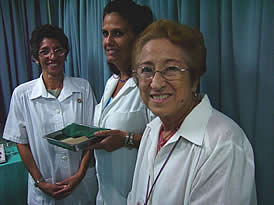When we think of Cuba, certain incongruous images come to mind: sandy beaches, salsa music, and poverty. But while the typical visitor to this little island nation is busy soaking up rays and drinking one too many Cuba Libres, poor little Cuba has been quietly accomplishing something that few western countries have been able to do: Develop a health care model that provides free universal health care blending and balancing western medicine with eastern, natural medicine.
Cuba’s health care system has always been a priority for Castro’s government. Article 50 of the country’s constitution states: “Everyone has the right to health protection and care. The state guarantees this right by providing free medical and hospital care by means of the installations of the rural medical service network, polyclinics, hospitals, preventative and specialized treatment centers; by providing free dental care; by promoting the health publicity campaigns, health education, regular medical examinations, general vaccinations and other measures to prevent the outbreak of disease.”
Here are some stats: The average life expectancy in Cuba has risen from 63 years in 1955 to 78 years in 2007. The infant mortality rate has dropped from 1960’s 54 deaths per 1000 children to 6.5 per 1000 in 2007. In 1957 Cuba had 128 physicians and dentists per 1000 people. In 2005, those numbers had swelled to 627 doctors and 94 dentists per 1000. To put that into perspective, the USA in 2005 had 225 doctors per 1000. In fact, Cuba performed better on all 3 criteria when compared to the USA.
But as a massage therapist and acupuncturist, I am more interested in how alternative or natural medicine was integrated into their health care model and offered free to all. The idealist in me would like to believe that Fidel or Che hatched up the idea while savouring a perfect cigar and planning their utopia on earth, but their medical miracle was born out of disaster and necessity. In 1992, the USA increased its trade embargo against Cuba by passing the Democracy Act which made it illegal for foreign subsidiaries of US companies to sell goods to Cuba (it was already illegal for American companies to sell goods to Cuba). It also forbade ships that had docked in Cuban ports from docking in any US port for 6 months. This, combined with the collapse of the Soviet Union and Soviet support and trade as well as Cuba defaulting on its foreign debt in 1986 made it very difficult for Cuba to purchase medical equipment, supplies and medicine.

The Chinese character for disaster is comprised of two other characters: one is the character meaning danger, the other means opportunity. With aspirin and other western goods being either unavailable or unaffordable, Cuba adopted a natural approach. Dr Fé Bosch had been sent to Sri Lanka and Vietnam in 1984 to study eastern medicine and the possibility of incorporating elements into the national health system. In 1992, the Ministry of Public Health approached Dr Bosch with a new proposition: develop a training program in acupuncture and natural medicine for the country’s doctors. In less than 2 years 20,000 health care professionals had been trained and Cuba was on the road to integrated health care.

susan
Interested in practicing osteopathic manipulative medicine in Cuba. I am a physician, NOT interested in practicing as a physician, but more in manipulative medicine. Any opportunities?
Admin
You might want to talk to some of the people I mentioned in the article. Perhaps they could give you some information. Or you could try talking to some of their associations about the regulatory requirements.